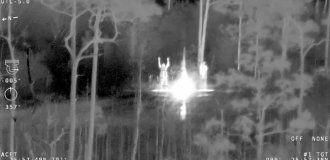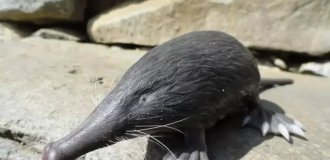20+ interesting space discoveries of our time (26 photos)
Space is so distant, mysterious, alluring researchers and ordinary people who are interested. Nowadays, many interesting discoveries have been made in field of space exploration. One can only guess whether dark matter, and why are there giant bubbles in space - and look forward to new discoveries of mankind. In the meantime, let's look at what has already been done. 
< br>
Star Collision 
In 2017, scientists recorded the collision of two neutron stars. This "space accident" gave rise to a powerful gravitational wave surge - GW170817. This was the first time that scientists have registered gravitational waves from the collision of neutron stars. These waves lead to the appearance of temporal-spatial curvature.
First photo of a black hole 
< br>
In 2019, scientists managed to get the first picture of the black holes. This black hole is at the center of the M87 galaxy 55 million light years from Earth.
Dark matter 
< br> According to astronomy, dark matter is a form of matter that is part of the universe, but does not enter into electromagnetic interaction - that is, does not emit light. It affects the movement of stars in galaxies, has a gravitational effect, and is surrounded by a veil mystery. So far, no one has been able to find it.
Tsunami and ice on Mars 
In 2016, a huge layer of ice was discovered under a layer of soil on Mars. 80-170 meters thick. A year later, a group of scientists from France and the United States determined that as a result of the fall of an asteroid on Mars, several billion years ago, a huge crater formed. In addition, he called a strong tsunami on the Red Planet - this was also traced along the coast sedimentary structures.
bubbles 
In 2010, astronomers found Fermi bubbles - two regions of weak X-ray radiation lying on both sides of the plane of our galaxies. They reach a width of about 300 light years, and their nature is still not clear to scientists. Only once did they suggest that the mysterious the bubbles are due to the activity of the supermassive black hole Sagittarius A*.
The search for a habitable planet 
< br> The search for another habitable planet has been going on for a long time. Among options at the moment - the exoplanet Ross 128b, discovered in 2017 year, and a super-Earth class planet called SPECULOOS-2c, discovered in 2022. The latter is farther from us than Ross128b, it is 40% larger than the Earth, and its Sun is six times smaller and twice as hot as ours.
Synestia theory 
It's just a theory, but... it still exists. Separate researchers suggest that once, about 4.5 billion years ago, our planet was shaped like a thick disk (like a doughnut). Initially, synestia is a hypothetical planetary body, formed after the collision of space objects.
Magnetic fields that "feed" the galaxy 
In 2018, scientists discovered an unusual function of magnetic fields in galaxy Cygnus A. These magnetic fields capture and hold dust, and "feed" the supermassive black hole at the center of the galaxy.
Ravenous black hole 
This year, an Australian team of astronomers discovered in the constellation Centauri a supermassive black hole that is growing at a record speed. It is 500 times larger than the hole at the center of the Milky Ways. A "gluttonous" black hole absorbs a volume of matter per second, equal to one earth.
SpaceX 
SpaceX space technology is changing the way we think about exploration space. These spaceships are multi-mission and multi-role use add pace to the study of planets and stars. By the way, all SpaceXlaunched 3556 Starlink satellites into orbit - with 2903 satellites are in working orbits.
"Alcoholic" comet 
Comet Lovejoy (C/2011 W3) releases large amounts of ethyl alcohol and sugar. According to astronomers, the comet "every second spewed into space as much alcohol as is contained in 500 bottles of wine." For scientists, this is another hint that comets, may have been involved in the origin of life on our planet.
An unusual star in the Orion Nebula 
In 2019, scientists discovered a newborn star in the Orion Nebula, which slightly turned the early ideas about the formation of stars. A bubble formed around it - and the stellar wind around it prevented the formation of new stars nearby. This is the first time that a stellar the wind prevented the birth of new stars.
James Webb telescope 
With the help of the James Webb Space Telescope, scientists can for the first time track moving asteroids, which was not possible before. His launched 11 months ago - December 25, 2021.
Rotating black holes 
< br> In 2015, there was a powerful explosion in space that was thought to was a supernova. However, in 2016 a group of researchers refuted. In fact, at that moment one of the stars was pulled spinning supermassive black hole - in the process this happened flash. Rotating black holes, it turns out, can also absorb external celestial bodies.
Asteroid Oumuamua 
In 2020, the Pan-STARRS 1 telescope in Hawaii discovered a new type space object - interstellar, not gravitationally connected with solar system. It was an object about the size of a football field, if not more - scientists wondered for a long time what it was, but came to the conclusion that in front of them is an asteroid. The object was named Oumuamua. It is believed that he arrived from a planet outside the solar system.
Epsilon Eridani 
In 2017, scientists discovered a nascent planetary system around the star Epsilon Eridani, very close to Earth (10.5 light years). It is assumed that from one to three planets revolve around the star.
Voyager 1 
< br> The Voyager 1 space probe, launched into space in 1977, in 2012 year became the first man-made terrestrial object to enter the interstellar space. He also became the first space probe to make detailed images of the moons of Jupiter and Saturn. The probe has been in flight for 45 years, and is currently about 14 billion miles from our planets.
"Ice Volcano" 
In 2015, scientists concluded that the largest mountain on the dwarf The planet Ceres is actually an icy cryovolcano. Wherein, the planet was probably geologically active during the last billion years (or maybe still active). It is believed that the cryovolcano spewed out icy salt water mixed with mud.
Gaia 
The Gaia Space Telescope was launched on December 19, 2013. Since the telescope makes a detailed map of the distribution of stars in our Galaxy, displaying 1.7 billion stars and helping scientists make new discoveries.
Cigar 
The Cigar Galaxy is known for the incredible speed with which it forms new stars - 10 times faster than the Milky Way. It is located at 12 millions of light years from us, and 5 times brighter than our galaxy.
water on the moon 
< br> In 2018, ice was discovered at the north and south poles of the moon. Then, with Every year, scientists find more and more frozen water in many craters. At the moment, in the region of the North Pole of the Moon in 40 craters there is about 0.6 km³ of ice. At the South Pole, 22% is covered with ice surface of Shackleton crater.
New galaxies 
So far, researchers have discovered 55 distant galaxies - and 44 of them have never been seen before.
Moons of Jupiter 
For 2022, it is known that Jupiter has 80 satellites, the sizes of which range from the planet Mercury to the size of a standard sports arenas. According to astronomers, this giant may have 20 more satellites They are currently awaiting confirmation. By the way, in August 2022 The James Webb Telescope saw and photographed the auroras on Jupiter.
The composition of the exoplanet 
< br> Another discovery on account of the James Webb telescope: he determined chemical and molecular composition of one of the exoplanets beyond solar system. Exoplanet WASP-39b contains in its atmosphere potassium, sodium, water, carbon dioxide, carbon monoxide and sulfur dioxide.
The oldest galaxy in the universe 
In July 2022, the James Webb Telescope discovered the galaxy GLASS-z13, which is now considered the oldest discovered to date. Now it is about 13.5 billion years old, and it was formed approximately 300 million years after the Big Bang.





















